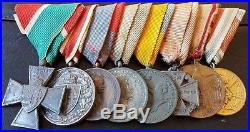
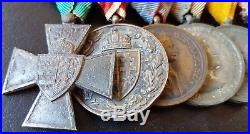
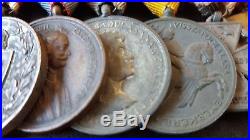
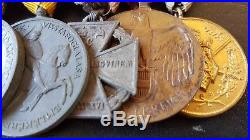
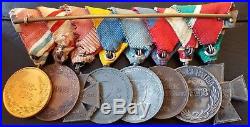
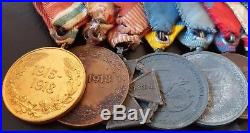
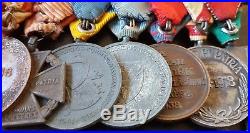
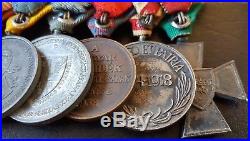
Original Austro-Hungarian Empire / Hungary Kingdom mounted medal group – WW1 / WW2: Hungarian National Defence Cross, Hungarian War Commemorative Medal Without Swords & Helmet. Hungarian War Commemorative Medal for Liberation of Transylvania, Hungarian War Commemorative Medal for Liberation of Upper Hungary, Hungarian War Commemorative Medal for Liberation of Southern Hungary. Austrian War Commemorative Medal. Bulgarian War Commemorative Medal. VERY NICE WORN CONDITION, BEAUTIFUL GROUP, PERFECT PIN DEVICE, ALL RIBBON ARE GENUINE, THE WW1 MEDALS’ RIBBONS LOOK MORE WORN BUT STILL OK. HISTORY OF THE AWARDS. National Defence Cross (Nemzetvédelmi Kereszt), 1940 – Silvered metal cross pattée, the arms stippled, with laterally-pierced ball suspension; the face with the arms of Hungary imposed centrally; the reverse with a central escutcheon inscribed A HAZÁÉRT (for the Homeland) and dated 1940′. The Cross was instituted 11 December 1940 with the intention initially of rewarding those who had resisted and defeated the Communist regime of Bela Kun in 1919 and latterly those who loyally served the Regent of Hungary and fought subversive elements during World War II. Hungarian Commemorative Medal of the World War – Awarded “with helmet and swords” to soldiers and other combattants or “without helmet and swords” to all other war participants or to the nearest relative of a soldier. This medal was instituted on 26 May 1929 by the Regent, Admiral Horthy. The obverse shows the weapon shield of Hungary surmounted by a crown and, if so awarded, with swords underneath the shield. In case of the award “without helmet and swords”, the ribbon is white with green-red-white side stripes. Commemorative Medal for the Liberation of Transylvania (Erdélyi Emlékérem), 1940 Circular medal in Kriegsmetall (zinc alloy) with laterally-pierced loop for ribbon suspension; the face with the head of King Mátyás Corvinus circumscribed ERDÉLYI RÉSZEK FELSZABADULÁSÁNAK EMLÉKÉRE (Medal for the Liberation of Part of Transylvania); the reverse with the arms of Transylvania circumscribed MÁTYÁS KIRÁLY SZÜLETÉSÉNEK 500 ÉVFORDULÓJÁN (King Mátyás 500th Anniversary of his Birthright) and inscribed around the rim VITÉZ NAGYBÁNYAI HORTHY MIKLÓS KORMÁNYZÓ ORSZÁGLÁSÁNAK XX ÉVÉBEN (In the 20th Year of the Regency of Valiant Miklós Horthy de Nagybányai). The medal was instituted on 1 October 1940 to mark the return of part of Transylvania to Hungary. At the end of World War I, Hungary lost almost three-quarters of its territory, amongst them many areas with large Hungarian populations, including Transylvania. In mid-1940, with Romania under pressure from the Soviet Union and Bulgaria, Hungary lodged a claim to Transylvania. Germany and Italy led arbitration at Vienna and on 30 August Romania ceded approximately 43,500 square kilometres of territory and almost 2,400,000 people in northwest Transylvania to Hungary. In 1479 to 1483 he retook Transylvania from the Ottoman Turks and is revered in Hungary as a national hero. Commemorative Medal for the Liberation of Upper Hungary (Felvidéki Emlékérem), 1938 Circular bronze medal with laterally-pierced loop for ribbon suspension; the face with the head and shoulders portrait of Francis II Rákóczi in armour facing right, circumscribed PRO PATRIA ET LIBERTATE RÁKÓCZI (For Fatherland and Liberty Rákóczi); the reverse inscribed A MAGYAR FELVIDÉK FELSZABADULÁSÁNAK EMLÉKÉRE (Medal for the Liberation of Upper Hungary). The medal was instituted on 4 November 1938. At the end of World War I, Hungary lost almost three-quarters of its territory, amongst them many areas with large Hungarian populations, including areas of southern Slovakia and southern Carpathian Rus. The Munich Agreement between Germany, Britain, France and Italy dealt not only with the question of the Sudeten Germans but also called for a settlement of Hungarian claims on this Czechoslovak territory. German and Italian arbitration in Vienna led to an imposed settlement on 2 November 1938 by which almost 12,000 square kilometres of territory and over a million people were transferred to Hungary. The award was annulled after World War II and the territory divided between Slovakia and the Ukraine. He is revered in Hungary as a national hero. Commemorative Medal for the Liberation of Southern Hungary (Délvidéki Emlékérem), 1941 Circular medal in Kriegsmetall (zinc alloy) with laterally-pierced loop for ribbon suspension; the face with John Hunyadi circumscribed MAGYAR DÉLVIDÉK VISSZAFOGLALÁSA EMLÉKÉRE (Medal for the Reoccupation of Southern Hungary); the reverse with the arms of Southern Hungary circumscribed VITÉZ NAGYBÁNYAI HORTHY MIKLÓS KORMÁNYZÓSÁGÁNAK XXII ÉVÉBEN (In the 22nd Year of the Regency of Valiant Miklós Horthy de Nagybányai). The medal was instituted on 11 April 1941 to mark the return of Southern Hungary to Hungary. At the end of World War I, Hungary lost almost three-quarters of its territory, amongst them many areas with large Hungarian populations, including Southern Hungary. Karl Troop Cross (Karl Truppenkreuz) was instituted on 13 December 1916 by Emperor Karl I of Austria-Hungary. The cross was awarded until the end of the First World War to soldiers of the Austro-Hungarian Army , regardless of rank, who had been with a combatant unit for at least twelve weeks and who had actually served at the front. The medal is of zinc and consists of a cross pattée resting on a laurel wreath. The reverse shows the Austrian and Hungarian Imperial crowns above the letter “C” (for Carolus) with the inscription “VITEM ET SANGVINEM”, (With life and blood) and the date MDCCCCXVI, (1916). The cross was worn on the left chest from a red ribbon with alternate red-white side strips towards each edge. A total of 651,000 were awarded. Austrian War Commemorative Medal (Kriegserinnerungsmedaille) Awarded to all who served in the First World War. This medal was instituted on 21 december 1932 and on 10 November 1933 gilt crossed swords were decreed. These were to be attached to the medal’s ribbon for those who served under fire at the front, wounded and POW who had behaved with honour. The obverse depicts an eagle with wings opened downwards, standing on an upright shield with the Austrian weapon. Along the lower rim are the words “FÜR ÖSTERREICH” (For Austria). The medal is 3.6mm thick and thus of Swiss manufacture. The medal was created by decree on 9 December 1933 and awarded to all participants then living in World War I, both military and civilian, until 31 December 1939. The medal could be awarded to military from the Central Powers and to foreign citizens; in the event the largest such group was German military. Bulgaria felt a great sense of grievance following the loss of territory at the conclusion of the second Balkan War in 1913. When Germany offered to restore all of the lands she had been promised in 1878, Bulgaria, which had the largest army in the Balkans, declared war on Serbia in October 1915. In return, Britain, France and Italy then declared war on Bulgaria. After initial victories, the war became unpopular because of food and other shortages and the revolution in Russia in 1917 had a profound effect on Bulgarian sentiment. When the Allies finally broke out of the Salonika pocket, Bulgaria sued for peace and King Ferdinand I abdicated in favour of his son who became King Boris III. The Treaty of Neuilly that concluded the war took significant territory from Bulgaria and imposed severe restrictions on the future size of her armed forces. The item “7722 Austro-Hungarian mounted medal group WW1 WW2 Defence Cross Karl Troop” is in sale since Thursday, April 12, 2018. This item is in the category “Collectables\Militaria\World War I (1914-1918)\Medals/ Ribbons”. The seller is “a..anderson” and is located in Abbots Langley. This item can be shipped worldwide.
- Type: Medals & Ribbons
- Era: 1914-1945
- Conflict: World War I (1914-1918)
- Country/ Organization: Germany